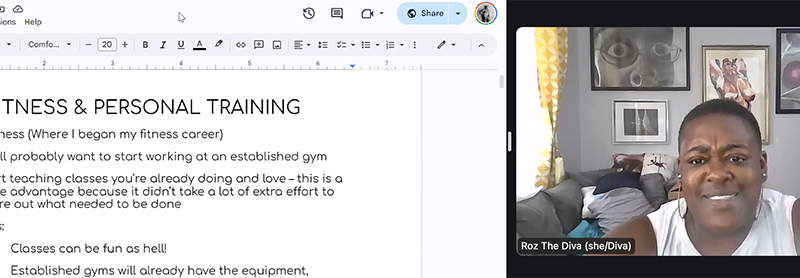[memberonly level=“Group Membership for Businesses of 2-5 individuals, Student, Individual or Solo-Preneur”] Please note that…

How to use Project Manager Mode in Your Pole Biz (Part 1)
How to use Project Manager Mode in Your Pole Biz (Part 1)
How to manage your workload so you can spend more time hanging upside down with your clients
This IPIA resource post is based on content shared by Seonaidh Jamieson, the Neurodivergent Project Manager from her webinar for the IPIA in 2023.
Pole businesses are dynamic and exciting… and also sometimes stressful and overwhelming. If you’re caught up in the day-to-day, finding yourself firefighting, or are waiting for the right moment to take on that dream project, well, you’re in the right place.
“Project Manager Mode” is who we are when we are organized, strategic and unstoppable. Focused on our end goal and confident that we’ll get there, this is who we all need on our side when planning our next big move. You don’t need to change who you are to embrace your Project Manager mode, you just need a change in perspective and a few key skills…
You can’t see the label from inside the jam jar.
Project management isn’t about bureaucracy (or at least, it shouldn’t be), but instead about making sure the right stuff happens at the right time. If running your pole business is the jam inside the jar, your Project Manager Mode is looking at the label. From here you can see all of the components of your business, how much sugar, how many strawberries, and how many coveted bottles of Dry Hands are in each jar. You are stepping out of your productive flow (momentarily) to assess, plan, and pave the way for your business to keep going and growing.
When you gear up to work towards your biggest pole goals, you need to make changes. That is a project, and all projects (no matter their size) have four key stages: scoping, planning, delivering, and reviewing. Your Project Manager Mode has a job at each stage, and that job is to make it as easy as possible for you to make progress…
We’ll cover the first two stages in this post and the second two stages in the next post!
1. Scoping
Imagine you’ve bought a plot of land and you are building your very own luxury pole and aerial facility. You hire the very best contractors and when they arrive you hand them your plan and tell them when the grand opening will be.
But the plan doesn’t make sense.
The utilities are in the wrong place, the slope is in the opposite direction, and the physical therapy room is in the middle of your neighbor’s garden. The foreman hands you back your plan and gives you the number of an architect.
The architect gets in touch with SO MANY QUESTIONS. They visit the site, they ask for maps and boundaries and permissions. It takes about a month, but with new information in hand you can hand your new plan over to your contractors. They build your beautiful studio in time for the new grand opening—2 months’ after your original date.
Sure, the first plan was gorgeous and very quick… but it wasn’t actually possible from your starting point. That’s why we need to scope out our projects.t doesn’t matter how good a plan is, if it’s not rooted in reality it’s not going to work.
When you engage your Project Manager Mode to scope out your projects, you need to know where you are now, where you want to go, and what you need to get there. You can scope out your project in three steps…
- Brainstorm everything about this project on post-its, mind maps, or lists, e.g. tasks, deadlines, people involved, constraints, considerations.
- Look for any gaps.hat action do you need to take to fill in the gaps? Write down those actions.
- Is there anything here that’s unclear, or is there anything still lingering in the back of your mind? Write those down too!
This stage can be very quick, but for big projects can take years. Take your time, and use this as an opportunity to get all possibilities and potential barriers out in front of you. Then when you’re ready, you can make your plan…
2. Planning
You’ve laid out all of your pole-project ingredients, and now it’s time to put them together in three steps:
- Create some logic in your post-its, mind maps, or lists.
Working with the information you have in front of you, start to lay it out in a logical order or in logical groupings. You may have several concurrent mini-projects, strict deadlines, or changes to consider so remember that this is an iterative process. This step is about creating enough of a framework to support you in the next stage, so it doesn’t need to be perfect!
- Add your plan to your project management software (Seonaidh recommends Asana!)
This is a project, not a list of tasks, so using project management software will allow you to see the overview of this project and the tasks assigned to you.
Create a space for your project and start adding your tasks, milestones, and decisions. During this stage your Project Manager Mode is making instructions for “future you” to follow. To make it as easy as possible to follow, make sure each task is an instruction to take a specific action and has a clear deadline. You need to know exactly what each task means from the title alone (the amount of detail you will need varies from person to person).
- Sense check your plan and tweak if needed.
Once you’ve got your first draft, make sure you have enough time to deliver the tasks assigned to each week. If not, adjust the dates. Check both in this project and against any other projects you have on the go.Asana allows you to toggle between individual projects and all of your assigned tasks so you can get a sense for your workload each week.
Planning in Asana Top Tips!
- Make sure each task has a due date and assigned person.
- If you’re not sure what a task means, scope it out and break it down into clearer tasks.
- If you struggle to break down bigger tasks, check out Goblin Tools!
- Make sure your plan is feasible and not reliant on dangerous levels of caffeine consumption.
- Once you’ve made your plan for this project, toggle to ‘My Tasks’ and check for any clashes or over scheduled weeks. Better to spot and fix these now!
Remember this plan is your best guess about the future. Once you start working through your plan it will change. This is normal, and why your Project Manager Mode still has a job in the next two stages which we’ll cover in the next post!



